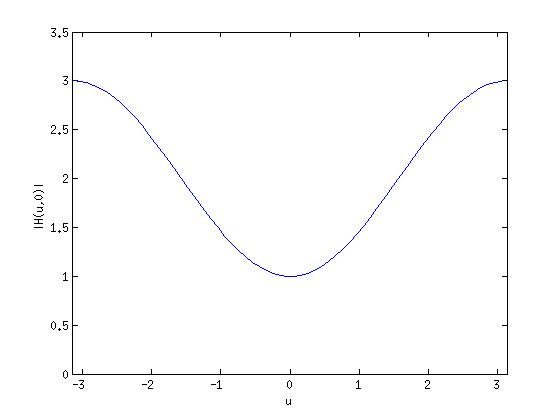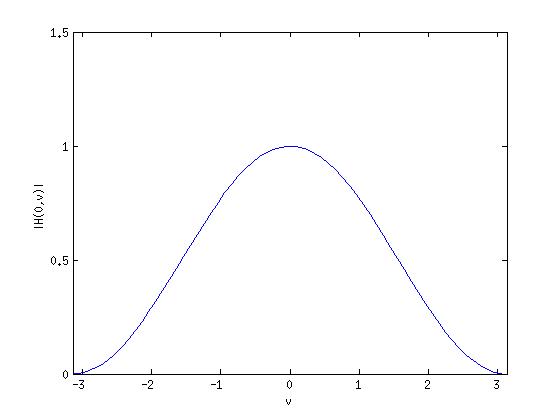| Line 24: | Line 24: | ||
b) Is this filter separable? Answer yes/no and justify your answer. | b) Is this filter separable? Answer yes/no and justify your answer. | ||
| − | c) Compute the | + | c) Compute the DSFT H(u,v) of this filter. Sketch the plot of H(u,0). Sketch the plot of H(0,v). What are the characteristics of this filter (low-pass, band-pass, or high-pass)? |
d) What is the output image when this filter is applied to the following image (using symmetric boundary conditions)? | d) What is the output image when this filter is applied to the following image (using symmetric boundary conditions)? | ||
| Line 61: | Line 61: | ||
b) Is this filter separable? Answer yes/no and justify your answer. | b) Is this filter separable? Answer yes/no and justify your answer. | ||
| − | c) Compute the | + | c) Compute the DSFT H(u,v) of this filter. Sketch the plot of H(u,0). Sketch the plot of H(0,v). What are the characteristics of this filter (low-pass, band-pass, or high-pass)? |
d) What is the output image when this filter is applied to the following image (using symmetric boundary conditions)? | d) What is the output image when this filter is applied to the following image (using symmetric boundary conditions)? | ||
| Line 129: | Line 129: | ||
<math>h_2[n] = \frac{1}{2}\delta[n+1] + \delta[n] +\frac{1}{2}\delta[n-1]</math> | <math>h_2[n] = \frac{1}{2}\delta[n+1] + \delta[n] +\frac{1}{2}\delta[n-1]</math> | ||
| − | c) Compute the | + | c) Compute the DSFT H(u,v) of this filter. Sketch the plot of H(u,0). Sketch the plot of H(0,v). What are the characteristics of this filter (low-pass, band-pass, or high-pass)? |
Revision as of 17:05, 1 December 2014
Contents
Homework 11, ECE438, Fall 2014, Prof. Boutin
Question 1
Consider the following filter:
$ h[m,n]: \begin{array}{cccc} & m=-1 & m=0 & m=1 \\ n=1&\frac{1}{16} & \frac{2}{16} & \frac{1}{16} \\ n=0&\frac{2}{16} & \frac{4}{16} & \frac{2}{16} \\ n=-1&\frac{1}{16} & \frac{2}{16} & \frac{1}{16} \end{array} $
a) Write a difference equation that can be used to implement this filter.
b) Is this filter separable? Answer yes/no and justify your answer.
c) Compute the DSFT H(u,v) of this filter. Sketch the plot of H(u,0). Sketch the plot of H(0,v). What are the characteristics of this filter (low-pass, band-pass, or high-pass)?
d) What is the output image when this filter is applied to the following image (using symmetric boundary conditions)?
$ g[m,n]: \begin{array}{ccccccccccc} 0 & 0 & 0 & 0 & 0 & 0 & 0 & 0 & 0 & 0 & 0\\ 0 & 0 & 0 & 0 & 0 & 0 & 0 & 0 & 0 & 0 & 0\\ 0 & 0 & 0 & 0 & 0 & 0 & 0 & 0 & 0 & 0 & 0\\ 0 & 0 & 0 & 0 & 0 & 0 & 0 & 0 & 0 & 0 & 0\\ 0 & 1 & 1 & 1 & 1 & 1 & 1 & 1 & 1 & 1 & 0\\ 0 & 1 & 1 & 1 & 1 & 1 & 1 & 1 & 1 & 1 & 0\\ 0 & 1 & 1 & 1 & 1 & 1 & 1 & 1 & 1 & 1 & 0\\ 0 & 1 & 1 & 1 & 1 & 1 & 1 & 1 & 1 & 1 & 0\\ 0 & 1 & 1 & 1 & 1 & 1 & 1 & 1 & 1 & 1 & 0\\ 0 & 1 & 1 & 1 & 1 & 1 & 1 & 1 & 1 & 1 & 0\\ 0 & 0 & 0 & 0 & 0 & 0 & 0 & 0 & 0 & 0 & 0\\ \end{array} $
Question 2
Consider the following filter:
$ h[m,n]: \begin{array}{cccc} & m=-1 & m=0 & m=1 \\ n=1&-\frac{1}{9} & -\frac{1}{9} & -\frac{1}{9} \\ n=0&-\frac{1}{9} & -\frac{8}{9} & -\frac{1}{9} \\ n=-1&-\frac{1}{9} &- \frac{1}{9} & -\frac{1}{9} \end{array} $
a) Write a difference equation that can be used to implement this filter.
b) Is this filter separable? Answer yes/no and justify your answer.
c) Compute the DSFT H(u,v) of this filter. Sketch the plot of H(u,0). Sketch the plot of H(0,v). What are the characteristics of this filter (low-pass, band-pass, or high-pass)?
d) What is the output image when this filter is applied to the following image (using symmetric boundary conditions)?
$ g[m,n]: \begin{array}{ccccccccccc} 0 & 0 & 0 & 0 & 0 & 0 & 0 & 0 & 0 & 0 & 0\\ 0 & 0 & 0 & 0 & 0 & 0 & 0 & 0 & 0 & 0 & 0\\ 0 & 0 & 0 & 0 & 0 & 0 & 0 & 0 & 0 & 0 & 0\\ 0 & 0 & 0 & 0 & 0 & 0 & 0 & 0 & 0 & 0 & 0\\ 0 & 1 & 1 & 1 & 1 & 1 & 1 & 1 & 1 & 1 & 0\\ 0 & 1 & 1 & 1 & 1 & 1 & 1 & 1 & 1 & 1 & 0\\ 0 & 1 & 1 & 1 & 1 & 1 & 1 & 1 & 1 & 1 & 0\\ 0 & 1 & 1 & 1 & 1 & 1 & 1 & 1 & 1 & 1 & 0\\ 0 & 1 & 1 & 1 & 1 & 1 & 1 & 1 & 1 & 1 & 0\\ 0 & 1 & 1 & 1 & 1 & 1 & 1 & 1 & 1 & 1 & 0\\ 0 & 0 & 0 & 0 & 0 & 0 & 0 & 0 & 0 & 0 & 0\\ \end{array} $
Question 3
Consider the following filter:
$ h[m,n]: \begin{array}{cccc} & m=-1 & m=0 & m=1 \\ n=1&-\frac{1}{8} & \frac{1}{2} & -\frac{1}{8} \\ n=0&-\frac{1}{4} & 1 & -\frac{1}{4} \\ n=-1&-\frac{1}{8} & \frac{1}{2} & -\frac{1}{8} \end{array} $
a) Write a difference equation that can be used to implement this filter.
$ \begin{align} y[m,n] =& -\frac{1}{8}x[m+1,n-1] + \frac{1}{2}x[m,n-1] - \frac{1}{8}x[m-1,n-1] \\ & -\frac{1}{4}x[m+1,n] + x[m,n] -\frac{1}{4}x[m,n-1] \\ & -\frac{1}{8}x[m+1,n+1] + \frac{1}{2}x[m,n+1] -\frac{1}{8}x[m-1,n+1] \end{align} $
b) Is this filter separable? Answer yes/no and justify your answer.
Yes. The coefficient matrix of h[m,n] can be written as product of two vectors.
$ \begin{pmatrix} -\frac{1}{8} & \frac{1}{2} & -\frac{1}{8} \\ -\frac{1}{4} & 1 & -\frac{1}{4} \\ -\frac{1}{8} & \frac{1}{2} & -\frac{1}{8} \end{pmatrix} = \begin{pmatrix} \frac{1}{2} \\ 1 \\ \frac{1}{2} \end{pmatrix} \cdot \begin{pmatrix} -\frac{1}{4} & 1 & -\frac{1}{4} \end{pmatrix} $
Therefore the filter can be separate into two 1-D filters.
$ h_1[m] = -\frac{1}{4}\delta[m+1] + \delta[m] -\frac{1}{4}\delta[m-1] $
$ h_2[n] = \frac{1}{2}\delta[n+1] + \delta[n] +\frac{1}{2}\delta[n-1] $
c) Compute the DSFT H(u,v) of this filter. Sketch the plot of H(u,0). Sketch the plot of H(0,v). What are the characteristics of this filter (low-pass, band-pass, or high-pass)?
$ H_1(\mu) = DTFT\{h_1[m]\} = -\frac{1}{4}e^{-j\mu(-1)} + e^{-j\mu(0)} -\frac{1}{4}e^{-j\mu(1)} = 1-\frac{1}{2}cos\mu $
$ H_2(\nu) = DTFT\{h_2[n]\} = \frac{1}{2}e^{-j\nu(-1)} + e^{-j\nu(0)} +\frac{1}{2}e^{-j\nu(1)} = 1+cos\nu $
Using the separability,
$ H(\mu, \nu) = DSFT\{ h[m,n]\} = H_1(\mu)\cdot H_2(\nu) = (1-\frac{1}{2}cos\mu)(1+cos\nu) $
$ H(\mu, 0) = 2(1-\frac{1}{2}cos\mu) $
$ H(0, \nu) = \frac{1}{2}(1+cos\nu) $
d) What is the output image when this filter is applied to the following image (using symmetric boundary conditions)?
$ g[m,n]: \begin{array}{ccccccccccc} 0 & 0 & 0 & 0 & 0 & 0 & 0 & 0 & 0 & 0 & 0\\ 0 & 0 & 0 & 0 & 0 & 0 & 0 & 0 & 0 & 0 & 0\\ 0 & 0 & 0 & 0 & 0 & 0 & 0 & 0 & 0 & 0 & 0\\ 0 & 0 & 0 & 1 & 1 & 1 & 1 & 1 & 0 & 0 & 0\\ 0 & 0 & 1 & 1 & 1 & 1 & 1 & 1 & 1 & 0 & 0\\ 0 & 1 & 1 & 1 & 1 & 1 & 1 & 1 & 1 & 1 & 0\\ 0 & 1 & 1 & 1 & 1 & 1 & 1 & 1 & 1 & 1 & 0\\ 0 & 1 & 1 & 1 & 1 & 1 & 1 & 1 & 1 & 1 & 0\\ 0 & 1 & 1 & 1 & 1 & 1 & 1 & 1 & 1 & 1 & 0\\ 0 & 1 & 1 & 1 & 1 & 1 & 1 & 1 & 1 & 1 & 0\\ 0 & 0 & 0 & 0 & 0 & 0 & 0 & 0 & 0 & 0 & 0\\ \end{array} $
$ g[m,n]**h[m,n]: \begin{array}{cccccccccccc} 0 & 0 & 0 & 0 & -\frac{1}{8} & \frac{1}{2} & -\frac{1}{8} & 0 & 0 & 0& 0 \\ 0 & 0 & 0 & -\frac{1}{8} & \frac{1}{8} & \frac{10}{8} & \frac{1}{8} & -\frac{1}{8} & 0 & 0 & 0 \\ 0 & 0 & -\frac{1}{8} & \frac{1}{8} & \frac{7}{8} & \frac{10}{8} & \frac{7}{8} & \frac{1}{8} & -\frac{1}{8} & 0 & 0 \\ 0 & -\frac{1}{8} & \frac{1}{8} & \frac{7}{8} & \frac{9}{8} & 1 & \frac{9}{8} & \frac{7}{8} & \frac{1}{8} & -\frac{1}{8} & 0 \\ -\frac{1}{8} & \frac{1}{8} & \frac{7}{8} & \frac{9}{8} & 1 & 1 & 1 & \frac{9}{8} & \frac{7}{8} & \frac{1}{8} & -\frac{1}{8} \\ -\frac{3}{8} & 1 & \frac{9}{8} & 1 & 1 & 1 & 1 & 1 & \frac{9}{8} & 1 & -\frac{3}{8} \\ -\frac{1}{2} & \frac{3}{2} & 1 & 1 & 1 & 1 & 1 & 1 & 1 & \frac{3}{2} & -\frac{1}{2} \\ -\frac{1}{2} & \frac{3}{2} & 1 & 1 & 1 & 1 & 1 & 1 & 1 & \frac{3}{2} & -\frac{1}{2} \\ -\frac{1}{2} & \frac{3}{2} & 1 & 1 & 1 & 1 & 1 & 1 & 1 & \frac{3}{2} & -\frac{1}{2} \\ -\frac{3}{8} & \frac{9}{8} & \frac{6}{8} & \frac{6}{8} & \frac{6}{8} & \frac{6}{8} & \frac{6}{8} & \frac{6}{8} & \frac{6}{8} & \frac{9}{8} & -\frac{3}{8} \\ -\frac{1}{8} & \frac{3}{8} & \frac{1}{2} & \frac{1}{2} & \frac{1}{2} & \frac{1}{2} & \frac{1}{2} & \frac{1}{2} & \frac{1}{2} & \frac{3}{8} & -\frac{1}{8} \end{array} $
Discussion
You may discuss the homework below.
- write comment/question here
- answer will go here



